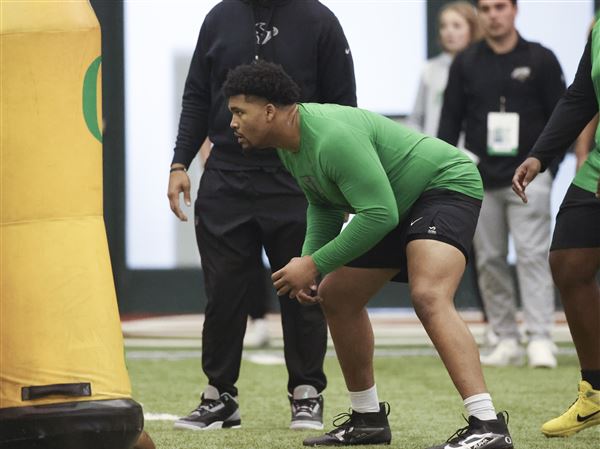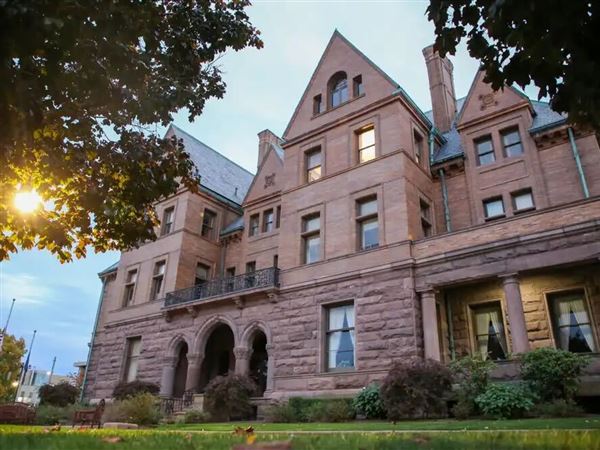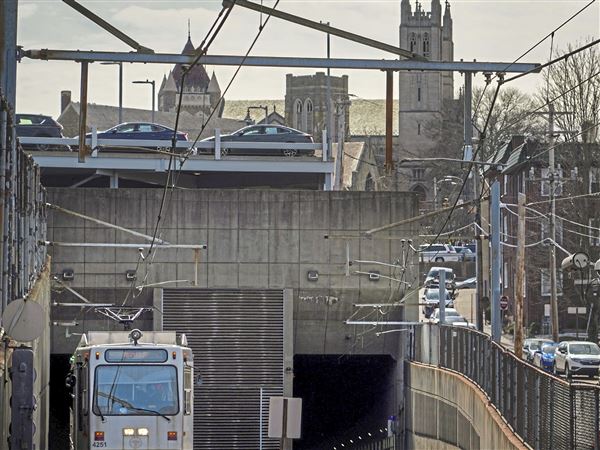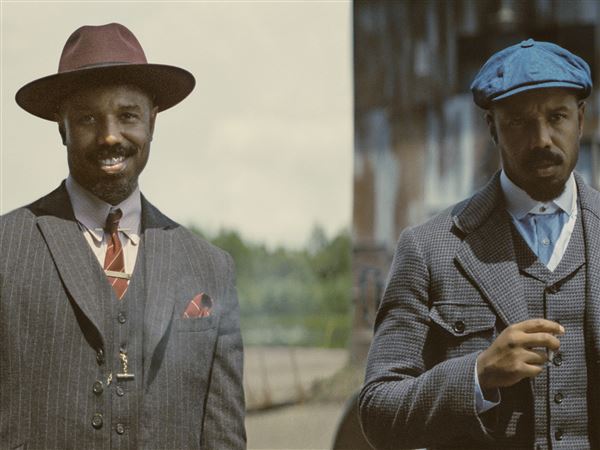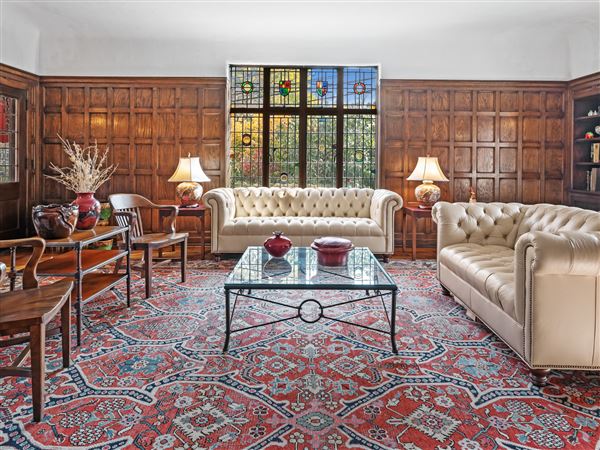BEVERLY HILLS, Calif. — For the South Side-based Fred Rogers Company, its latest series marks a return to form and a big departure all at once. PBS’s “Odd Squad,” which premieres with back-to-back episodes at 9 a.m. Wednesday on WQED-TV, is the company’s first live-action property since “Mister Rogers’ Neighborhood” wrapped production in 2000.
But “Odd Squad” is also a far cry from the quiet, slow-moving style of Fred Rogers. Rather, it’s frantic, fast-paced and filled with comedic gags as it attempts to teach math concepts to viewers ages 5 to 8.
Each half-hour episode has two 11-minute stories that follow the adventures of pint-sized agents in investigative agency Odd Squad.
Olive (Dalila Bela) and her new partner Otto (Filip Geljo) attempt to unravel mysterious goings-on — disappearing zeroes, runaway dinosaurs, the impact of unlucky number 13 — using math concepts they work through after teleporting into the mysterious Mathroom.
Like its most recent series, 2013’s “Peg + Cat,” “Odd Squad” is produced by FRC, but the local company is not that involved in the show’s creative content. Unlike on the animated “Daniel Tiger’s Neighborhood,” which films live-action interstitials locally and gets script notes from employees at FRC, “Odd Squad” is produced in Toronto and is the brainchild of veteran kids TV producers Tim McKeon (“Adventure Time”) and Adam Peltzman (“The Backyardigans”).
“We got involved with the show after it had been picked up by PBS,” explained FRC vice president of broadcast and digital media Paul Siefken. “We’re the U.S. partner on the project, facilitating to make sure everybody has what they need.”
Producer J.J. Johnson’s Toronto-based Sinking Ship Entertainment (“Annedroids”) also produces “Odd Squad.” FRC had been in conversation with Mr. Johnson before “Odd Squad” came to exist.
“We brought J.J. down to Pittsburgh and talked to him and thought he had a great rapport with kids, and the work he was doing was educational and funny and engaging, and that’s ultimately the kind of work we want to be doing, the kind of work we want to be partners with,” Mr. Siefken said in July following a PBS press conference at the TV critics summer press tour. “The tag line of our company is ‘the legacy lives on,’ and we think the best way for the legacy of great children’s programming to continue is to partner with the best creators of children’s content out there, so we’re very proud to be associated with the program.”
Mr. McKeon and Mr. Peltzman began working on “Odd Squad” in do-it-yourself style once they learned PBS was seeking a math show for children.
“We did bounce around a few other ideas before landing on this one, but one of the things that drew us to this idea was doing a live-action show where the kids are in charge, kids have the power and kids wear suits and they’re from an agency,” Mr. Peltzman said.
Indeed, the stars of “Odd Squad” seem like they could be junior agents from the “Men in Black” movies. But a live-action show on PBS is somewhat unusual. These days the public broadcast usually makes animated series rather than live-action shows filled with special effects.
“Adam and I have both worked in animation, and I think when we came upon this idea, it didn’t feel as fun in animation,” Mr. McKeon said. “The whole premise is something odd happens. If you see the odd thing in live action it just pops more.”
The live-action style also feeds into the wish fulfillment of young viewers watching the show.
“We want kids watching to feel that there’s an Odd Squad branch in their town, and there’s just so much odd behavior that you need this huge operation, this huge headquarters just to deal with one town's bustling degree of odd activities,” Mr. Peltzman said. “So the live action really, really helps that because it grounds it in a place, and it grounds it in real kids, and I think it helps further the wish fulfillment angle.”
While it might seem like live action would be more expensive, Mr. Siefken said the cost of “Odd Squad” is pretty much in line with the company’s animated shows. The series is largely set on a giant Odd Squad headquarters set; filming on a set on a soundstage is more economical than filming on location.
“By building a large-scale set, we’re able to shoot two-thirds of the production on set, which is a cost savings,” he said. “And the only way to do a large-scale set is to have an order for 40 episodes [and amortize the cost of the set over those 40 episodes]. If you have a 13-episode order, you can’t afford to build a big set like that.”
The show’s 40-episode first season will play out over approximately the next two years, which is PBS’s typical new episode release pattern. Following the premiere, episodes will air weekdays at 7 a.m. on WQED-TV, including the Christmas-themed “Reindeer Games” episode Dec. 1. During December, 10 new episodes will roll out followed by an additional seven new episodes in January.
“Odd Squad” is funded in part by the U.S. Department of Education’s Ready to Learn grant, so math is always incorporated into episodes.
“What we found out early on is that a lot of odd things are nicely connected to math, or we can connect them to math,” Mr. Peltzman said. “So the idea that somebody is working so hard at delivering pizzas, she wishes there were two of her, suddenly, poof, she doubles. So you have this oddity that’s connected to the idea of doubling. That’s really where the stories come from for the show.”
Unlike most children’s TV programs, “Odd Squad” will have an element of an ongoing serialized story. Episodes will stand alone, but there will be a story thread that runs through the show’s first season.
“We’re very excited that there’s a story arc, which I think is rare in kids TV,” Mr. McKeon said. “At the end of the pilot, there’s a question raised about what happened to Olive’s old partner, and there’s sort of hints throughout the series about what happened to this old partner. And then halfway through the show, we pay it off and reveal what that mystery is, and we kind of turn the show in a new direction.”
Although the show’s sets, filled with slides from one level to another, are designed for kids — ceilings are low so when adults visit the Odd Squad HQ, they have to hunch over — the series is intended to continue even if its current stars grow too tall for the set.
“We didn’t call it ‘The Olive and Otto Show,’ we called it ‘Odd Squad,’ right?” Mr. McKeon said. “It’s about the organization. We were joking. I think we want to be like ‘CSI’ so we could have ‘Odd Squad: Miami’ eventually.”
First Published: November 23, 2014, 5:00 a.m.
